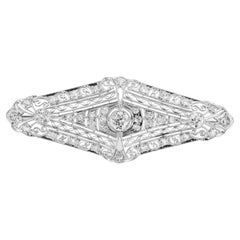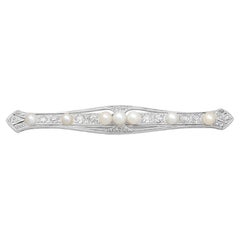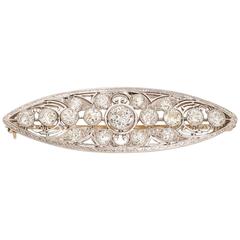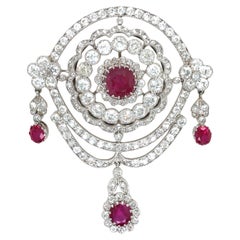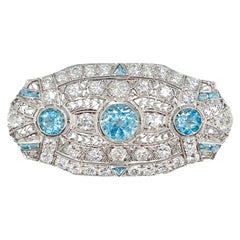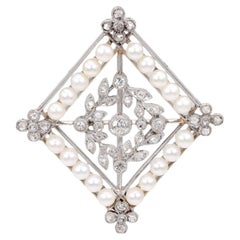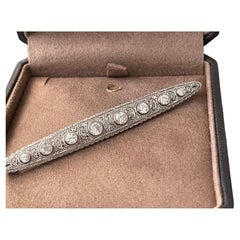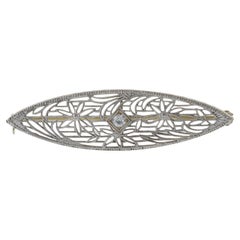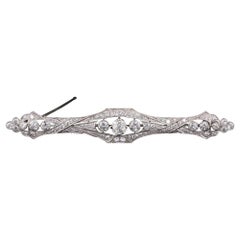Platinum Edwardian Brooch
Early 20th Century Edwardian Brooches
Diamond, Platinum, Gold, 14k Gold, White Gold
Vintage 1910s Unknown Edwardian Brooches
Diamond, Pearl, Platinum
Early 20th Century Edwardian Brooches
Diamond, 14k Gold, Yellow Gold, Platinum
Antique Early 1900s Edwardian Brooches
Diamond, Ruby, Platinum
Vintage 1910s Edwardian Brooches
Aquamarine, Diamond, Platinum
Early 20th Century Edwardian Brooches
Diamond, Pearl, Platinum
Antique 1890s Unknown Edwardian Brooches
Diamond, Platinum
Antique Early 1900s American Edwardian Brooches
Diamond, Platinum
Vintage 1920s Edwardian Brooches
Diamond, Platinum
Antique Early 1900s British Edwardian Brooches
Diamond, Peridot, Platinum
Vintage 1910s Edwardian Brooches
Diamond, Platinum
Vintage 1910s Edwardian Brooches
Diamond, Pearl, Platinum
Antique Late 19th Century Edwardian Brooches
Diamond, Platinum
Vintage 1910s Edwardian Brooches
Diamond, Gold, 10k Gold, Yellow Gold, Platinum
Vintage 1920s Unknown Edwardian Brooches
Diamond, Sapphire, Platinum
Early 20th Century British Brooches
Diamond, Platinum
Early 20th Century French Belle Époque Brooches
Diamond, Platinum
Antique Early 19th Century British Brooches
Diamond, Platinum
Antique Early 1900s Brooches
Diamond, 18k Gold, Platinum
Antique Late 19th Century Edwardian Brooches
Diamond, Platinum
Antique Early 1900s Edwardian Brooches
Diamond, Onyx, 14k Gold, Platinum
Early 20th Century Brooches
Diamond, Platinum
Vintage 1910s British Edwardian Brooches
Diamond, Gold, Platinum
Early 20th Century Brooches
Diamond, Platinum
Vintage 1920s European Brooches
White Diamond, Platinum
20th Century Edwardian Brooches
Diamond, Platinum
Vintage 1910s Unknown Edwardian Brooches
Diamond, Platinum
Antique Early 1900s Edwardian Brooches
Blue Sapphire, Yellow Gold, Platinum
Antique Early 1900s Edwardian Brooches
Diamond, Platinum
Vintage 1910s Edwardian Brooches
Diamond, White Diamond, Platinum
Vintage 1910s Edwardian Brooches
Diamond, Platinum
Vintage 1910s Edwardian Brooches
Diamond, Jade, Onyx, Ruby, Platinum
Vintage 1910s Edwardian Brooches
Diamond, Sapphire, Gold, Yellow Gold, Platinum
Vintage 1910s Edwardian Brooches
Diamond, Sapphire, Gold, 14k Gold, White Gold, Platinum
Antique Early 1900s Edwardian Brooches
Diamond, 18k Gold, Platinum
Early 20th Century Edwardian Brooches
White Diamond, Yellow Gold, Platinum
Early 20th Century American Edwardian Brooches
Diamond, Pearl, 14k Gold, Platinum
Vintage 1910s British Brooches
Diamond, Gold, Platinum
Antique Early 1900s Unknown Edwardian Brooches
Diamond, Pearl, Platinum
20th Century Edwardian Brooches
Diamond, 14k Gold, Platinum
Vintage 1910s Edwardian Brooches
Diamond, Gold, 18k Gold, Yellow Gold, Platinum
Early 20th Century Edwardian Brooches
Diamond, Garnet, Pearl, 18k Gold, White Gold, Platinum
Vintage 1910s Edwardian Brooches
Diamond, Platinum
Early 20th Century Edwardian Brooches
Diamond, White Diamond, Gold, White Gold, Platinum
Early 20th Century Unknown Edwardian Brooches
Pearl, Gold, Platinum
20th Century American Edwardian Brooches
Diamond, Platinum
Early 20th Century Unknown Edwardian Brooches
Diamond, Sapphire, White Diamond, Blue Sapphire, Platinum
Antique Early 1900s Edwardian Brooches
Diamond, White Diamond, Platinum
Antique Early 1900s Edwardian Brooches
Gold, 14k Gold, Yellow Gold, Platinum
Vintage 1910s Edwardian Brooches
Pearl, Sapphire, 15k Gold, Yellow Gold, Platinum
Antique Early 1900s Edwardian Brooches
Diamond, Sapphire, Platinum
Antique Early 1900s Edwardian Brooches
Diamond, Platinum
Vintage 1910s Edwardian Brooches
Diamond, Lapis Lazuli, 18k Gold, Platinum
Antique Early 1900s Edwardian Brooches
Diamond, Pearl, 18k Gold, Yellow Gold, Platinum
Vintage 1910s French Edwardian Brooches
Diamond, Pearl, 18k Gold, Platinum
20th Century British Edwardian Brooches
Diamond, Spinel, Platinum
Vintage 1910s Edwardian Brooches
Diamond, Opal, 18k Gold, Yellow Gold, Platinum
Antique Early 1900s British Edwardian Brooches
Diamond, Ruby, 15k Gold, Yellow Gold, Platinum
Vintage 1910s American Edwardian Brooches
Diamond, 18k Gold, Platinum
Vintage 1910s Unknown Edwardian Brooches
Diamond, 14k Gold, Platinum
- 1
- ...
Platinum Edwardian Brooch For Sale on 1stDibs
How Much is a Platinum Edwardian Brooch?
A Close Look at Edwardian Jewelry
Antique Edwardian jewelry is named for King Edward VII of Great Britain, who ruled from 1901 until 1910. Classic Edwardian necklaces, engagement rings, earrings and other jewelry are often overshadowed by the more popular style of the era, Art Nouveau, which is a shame. At its best, Edwardian jewelry was all about the exquisite diamond, platinum and pearl creations made by such famous names as Cartier and Boucheron.
Edward introduced incredibly formal Buckingham Palace court presentations, balls and soirées, resulting in a huge demand for diamond jewels starting with his coronation in 1902. Dozens of tiaras and formal jewels in an updated 18th-century style were purchased from French jewelers Boucheron and Chaumet and from Russia’s Fabergé. The court jewelers Asprey, Garrard, Carrington and the newly opened London branch of Cartier were all overwhelmed with orders for sumptuous diamond jewelry to be worn at the king’s elaborate coronation.
During the Edwardian era, pearls were more valuable than diamonds. The pear-shaped pearl La Peregrina, for example, belonged to some of the most fabulous and strongest women in history and bounced among royal courts in Spain, France and Russia for several centuries. So while today the scale and clarity of a diamond ring matters, back then the size and quantity of your pearls was more important a declaration of wealth. And just as Victorian notions of propriety and femininity began to change after Queen Victoria died in 1901, jewelry design also evolved but there was some overlap with late Victorian styles.
Women of the Edwardian period sported bejeweled headpieces like tiaras and bandeaus with feathered aigrettes. Another popular piece of jewelry that is said to have been directly inspired by Queen Alexandra were colliers de chien, or dog collars — today's choker necklaces — which consisted of either a ribbon decorated with a brooch, a gemstone or several strands of pearls strung closely together.
Two major jewelry houses, Cartier and Boucheron, were founded in the mid-1850s, and by the beginning of the 20th century, the wealthy considered them household names. The Cartier brand became even more desirable once the house became the official jewelry supplier to King Edward VII. Cartier took this title seriously and designed some of the most innovative jewelry of its day, since it was willing to experiment with new materials like platinum and because it was mindful of fashion trends. Filigree settings also became popular. This saw-piercing technique was decorative and at the same time created a sense of lightness.
Perhaps even more important than Cartier’s use of platinum was the founding of De Beers Consolidated Mines Limited in 1888. The discovery of new diamond mines made the stone more affordable and prompted the introduction of new gemstone cuts. It is not uncommon to see Edwardian jewels with baguette or briolette diamonds.
Find antique Edwardian rings, bracelets, watches and other jewelry on 1stDibs.
The Legacy of Diamond in Jewelry Design
Antique diamond rings, diamond tiaras and dazzling vintage diamond earrings are on the wish lists of every lover of fine jewelry. And diamonds and diamond jewelry are primarily associated with storybook engagements and red-carpet grand entrances — indeed, this ultra-cherished gemstone has a dramatic history on its hands.
From “A Diamond Is Forever” to “Diamonds Are a Girl’s Best Friend,” pop culture has ingrained in our minds that diamonds are the most desired, the most lasting and the most valuable gemstone. But what makes the diamond so special? Each stone — whether it’s rubies, sapphires or another stone — is unique and important in its own right. April babies might claim diamonds for themselves, but just about everyone wants this kind of sparkle in their lives!
There are several factors that set diamonds apart from other stones, and these points are important to our gem education.
Diamonds are minerals. They are made up of almost entirely of carbon (carbon comprises 99.95 percent; the remainder consists of various trace elements). Diamonds are the hardest gemstones, ranking number 10 on the Mohs Hardness Scale. Even its name, diamond, is rooted in the Greek adamas, or unconquerable. The only object that can scratch a diamond is another diamond. Diamonds are formed deep within the earth at very high temperatures (1,652–2,372 degrees Fahrenheit at depths between 90 and 120 miles beneath the earth’s surface) and are carried up by volcanic activity. Diamonds are quite rare, according to the Gemological Institute of America, and only 30 percent of all the diamonds mined in the world are gem quality.
In the 1950s, the Gemological Institute of America developed the 4Cs grading system to classify diamonds: clarity, color, cut and carat weight. Not all diamonds are created equal (there are diamonds, and then there are diamonds). The value of the diamond depends on the clarity (flawless diamonds are very rare but a diamond's value decreases if there are many blemishes or inclusions), color (the less color the higher the grade), cut (how the diamond’s facets catch the light, certain cuts of diamonds show off the stone better than others) and carat weight (the bigger, the better).
When you start shopping for a diamond engagement ring, always prioritize the cut, which plays the largest role in the diamond's beauty (taking the time to clean your diamond ring at least every six months or so plays a role in maintaining said beauty). And on 1stDibs, a range of buying guides can be found for those in the market for antique engagement rings, vintage engagement rings or Art Deco engagement rings.
Shop antique and vintage diamond rings, diamond necklaces and other extraordinary diamond jewelry on 1stDibs.
Finding the Right Brooches for You
Vintage brooches, which refer to decorative jewelry traditionally pinned to garments and used to fasten pieces of clothing together where needed, have seen increasing popularity in recent years.
While jewelry trends come and go, brooches are indeed back on the radar thanks to fashion houses like Gucci, Versace, Dior and Saint Laurent, all of which feature fun pinnable designs in their current collections. Whether a dazzlingly naturalistic Art Nouveau dragonfly, a whimsical David Webb animal, a gem-studded bloom or a streamlined abstract design, these jewels add color and sparkle to your look and a spring to your step.
Given their long history, brooches have expectedly taken on a variety of different shapes and forms over time, with jewelers turning to assorted methods of ornamentation for these accessories, including enameling and the integration of pearls and gemstones. Cameo brooches that originated during the Victorian age are characterized by a shell carved in raised relief that feature portraits of a woman’s profile, while 19th-century micromosaic brooches, comprising innumerable individually placed glass fragments, sometimes feature miniature depictions of a pastoral scene in daily Roman life.
At one time, brooches were symbols of wealth, made primarily from the finest metals and showcasing exquisite precious gemstones. Today, these jewels are inclusive and universal, and you don’t have to travel very far to find an admirer of brooches. They can be richly geometric in form, such as the ornate diamond pins dating from the Art Deco era, or designer-specific, such as the celebrated naturalistic works created by Tiffany & Co., the milk glass and gold confections crafted by Trifari or handmade vintage Chanel brooches of silk or laminated sheer fabric. Chanel, of course, has never abandoned this style, producing gorgeously baroque CC examples since the 1980s.
Brooches are versatile and adaptable. These decorative accessories can be worn in your hair, on hats, scarves and on the lower point of V-neck clothing. Pin a dazzling brooch to the lapel of your blazer-and-tee combo or add a cluster of smaller pins to your overcoat. And while brooches have their place in “mourning jewelry,” in that a mourning brooch is representative of your connection to a lost loved one, they’re widely seen as romantic and symbolic of love, so much so that a hardcore brooch enthusiast might advocate for brooches to be worn over the heart.
Today, find a wide variety of antique and vintage brooches for sale on 1stDibs, including gold brooches, sapphire brooches and more.
- What is Edwardian platinum?1 Answer1stDibs ExpertApril 5, 2022Edwardian jewelry is the last era of jewelry to be defined by a British monarch’s rule. For many of the Edwardian designs, platinum was the material of choice. In 1903, the invention of the acetylene torch meant that platinum’s dense, malleable form could be heated and fashioned into the desired jewelry designs. Shop a selection of Edwardian jewelry from some of the world’s top art dealers on 1stDibs.
